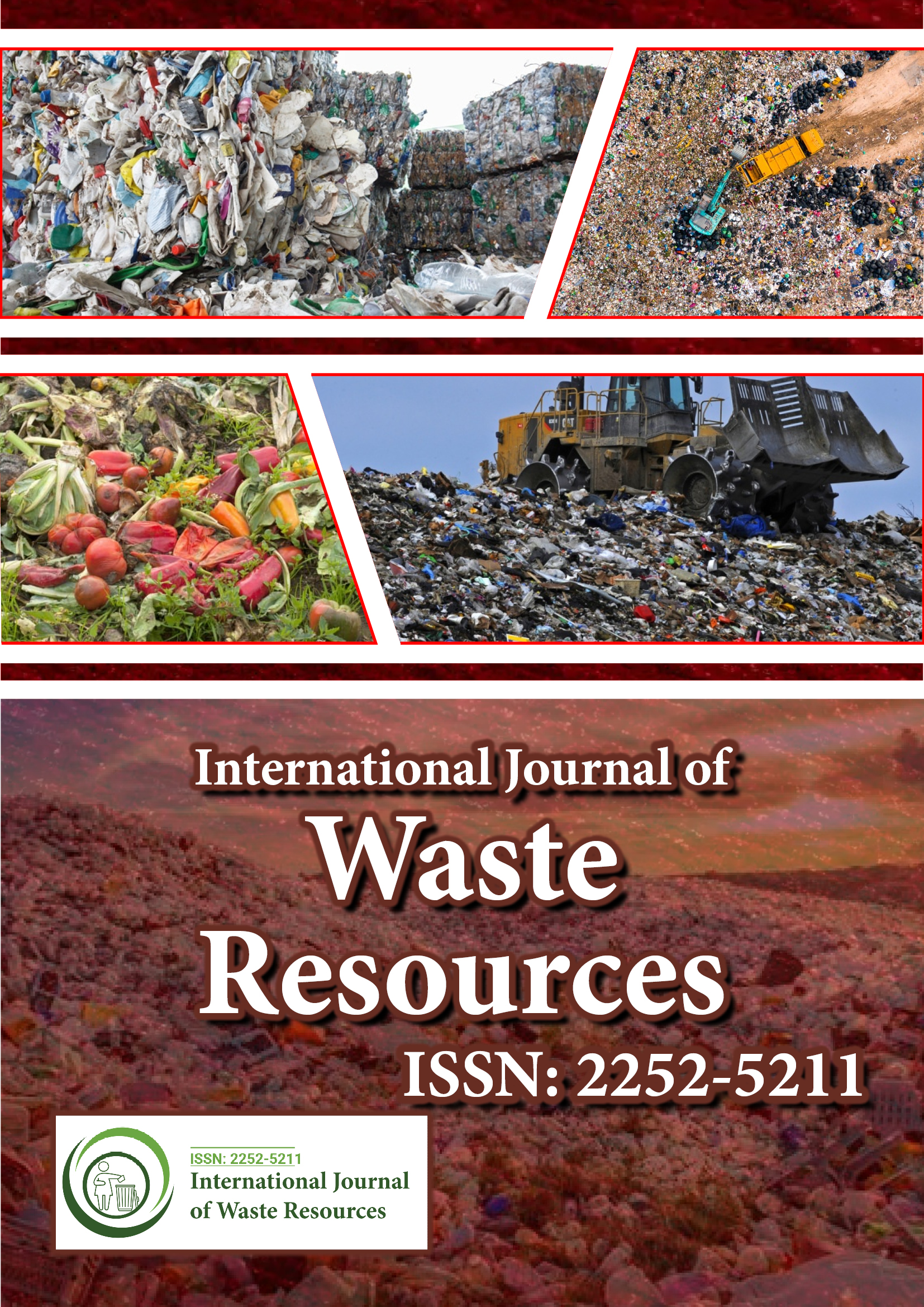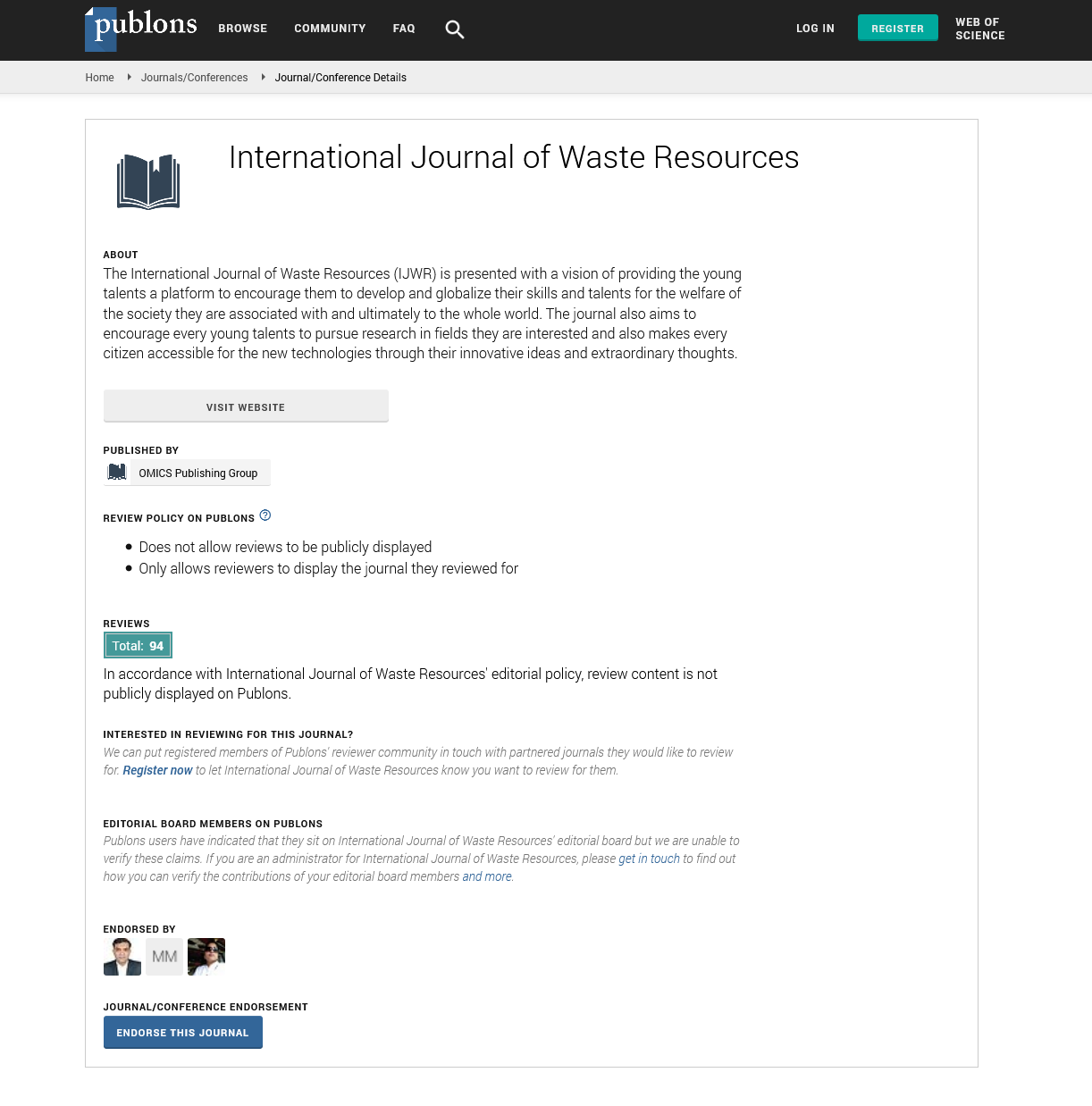Indexed In
- Open J Gate
- The Global Impact Factor (GIF)
- Open Archive Initiative
- VieSearch
- International Society of Universal Research in Sciences
- China National Knowledge Infrastructure (CNKI)
- CiteFactor
- Scimago
- Ulrich's Periodicals Directory
- Electronic Journals Library
- RefSeek
- Directory of Research Journal Indexing (DRJI)
- Hamdard University
- EBSCO A-Z
- Publons
- Google Scholar
Useful Links
Share This Page
Journal Flyer

Open Access Journals
- Agri and Aquaculture
- Biochemistry
- Bioinformatics & Systems Biology
- Business & Management
- Chemistry
- Clinical Sciences
- Engineering
- Food & Nutrition
- General Science
- Genetics & Molecular Biology
- Immunology & Microbiology
- Medical Sciences
- Neuroscience & Psychology
- Nursing & Health Care
- Pharmaceutical Sciences
Short Communication - (2024) Volume 14, Issue 3
Emerging Innovations in Waste-to-Resources Technologies: Advancing the Circular Economy
Concetta Vollprecht*Received: 28-Aug-2024, Manuscript No. IJWR-24-27475; Editor assigned: 30-Aug-2024, Pre QC No. IJWR-24-27475(PQ); Reviewed: 13-Sep-2024, QC No. IJWR-24-27475; Revised: 20-Sep-2024, Manuscript No. IJWR-24-27475(R); Published: 27-Sep-2024, DOI: 10.35248/2252-5211.24.14.589
Description
In recent years, addressing waste management through innovative technologies has emerged as a critical priority for societies worldwide. As the global economy faces mounting pressures from environmental degradation and resource scarcity, the transition towards a circular economy offers innovative solutions for sustainable growth [1]. This content examines future trends in Waste-to-Resources (WtR) technologies, how they could transform waste management into a regenerative, resource-efficient system and enable a paradigm shift towards a truly circular economy. At the core of Waste-to-Resources (WtR) technologies is the ability to transform waste materials into valuable resources [2,3]. This approach contrasts with the traditional "take-make-dispose" model, where end-of-life products are typically discarded. WtR technologies align with circular economy principles, aiming to keep materials in use for as long as possible, thereby reducing waste, lowering greenhouse gas emissions and conserving natural resources. Traditional recycling has long been a part of waste management, but advanced recycling techniques are now taking center stage. Chemical recycling processes, for instance, break down plastics into their raw components, which can then be reconstituted into highquality materials [4-6]. Similarly, upcycling adds further value by transforming discarded items into products of greater utility or artistic appeal, minimizing the need for virgin materials and promoting creativity in sustainable design. Biological treatments like Anaerobic Digestion (AD) and composting have proven effective in processing organic waste. Through these processes, waste can be converted into biogas, biofertilizers and other bioproducts. The demand for bioproducts continues to grow, particularly in agriculture, where they serve as eco-friendly alternatives to chemical fertilizers, enhancing soil health and supporting sustainable farming practices.
Traditional waste-to-energy plants focus on incinerating waste to generate electricity. Recent technological advancements focus on maximizing energy efficiency and minimizing negative environmental consequences. Gasification, pyrolysis and plasma arc gasification are modern WtE processes that break down waste at high temperatures without combustion, resulting in cleaner energy outputs, including syngas and synthetic fuels [7]. These technologies help reduce landfill dependency and provide a renewable energy source to power industries and communities. The rapid expansion of electronic devices has led to a surge in Electronic Waste (e-waste), often rich in metals like gold, silver and rare earth elements. Emerging e-waste recycling technologies can recover these valuable metals efficiently, reducing the need for mining. Urban mining, the process of reclaiming rare metals from e-waste has become a promising approach to recapturing high-value materials and reducing environmental impacts associated with resource extraction. The integration of digital technologies, such as the Internet of Things (IoT), Artificial Intelligence (AI) and blockchain, is revolutionizing waste management. Smart systems enable real-time tracking of waste streams, predictive analysis for waste collection and transparent data on material recovery [8]. This digital transformation promotes more efficient resource recovery, reduces operational costs and offers insights that support informed decision-making in resource management. Several factors contribute to the acceleration of WtR technologies, including regulatory pressures, public awareness and industry commitments to sustainability. Governments worldwide are adopting stricter regulations to reduce landfill use and enforce producer responsibility, driving manufacturers to rethink product design and embrace recyclable or biodegradable materials. Additionally, corporations and consumers alike are becoming more eco-conscious, influencing market demand for sustainable products and green solutions. While the potential of WtR technologies is vast, challenges remain, including the high costs of new technologies, logistical barriers and the need for skilled labor [9,10].
Conclusion
However, as investments in green technology increase, so does the opportunity for creating jobs, supporting local economies and encouraging sustainable practices across industries. Collaborative efforts between policymakers, businesses and communities will be essential to address these challenges and unlock the full potential of WtR technologies. Future developments might include the further adoption of zero-waste manufacturing practices, bioplastics and eco-friendly packaging. Additionally, as WtR technologies become more affordable and accessible, there is potential for widespread implementation in both developed and developing nations, fostering a global movement toward circularity.
References
- Kerdlap P, Low JS, Ramakrishna S. Zero waste manufacturing: A framework and review of technology, research, and implementation barriers for enabling a circular economy transition in Singapore. Resour Conserv Recycl. 2019;151:104438.
- Ghinea C, Gavrilescu M. Solid waste management for circular economy: Challenges and opportunities in Romania-The case study of Iasi Country. Towards Zero Waste: Circular Economy Boost, Waste to Resources. 2019:25-60.
- Cámara-Creixell J, Scheel-Mayenberger C. PetStar PET bottle-to-bottle recycling system, a zero-waste circular economy business model. Towards Zero Waste: Circular Economy Boost, Waste to Resources. 2019:191-213.
- Bates MP. From waste to resources-driving the circular economy. InEurasia 2018 Waste Management Symposium (EWMS2018) 2018.
- Hidalgo D, Martín-Marroquín JM, Corona F. A multi-waste management concept as a basis towards a circular economy model. Renew Sustain Energy Rev. 2019;111:481-489.
- Romero‐Hernandez O, Romero S. Maximizing the value of waste: From waste management to the circular economy. Thunderbird Int Bus Rev. 2018;60(5):757-764.
- Diaz LF. Waste management in developing countries and the circular economy. Waste Manag Res. 2017;35(1):1-2.
[Crossref] [Google Scholar] [PubMed]
- Ribić B, Voća N, Ilakovac B. Concept of sustainable waste management in the city of Zagreb: Towards the implementation of circular economy approach. J Air Waste Manag Assoc. 2017;67(2):241-259.
[Crossref] [Google Scholar] [PubMed]
- Hemidat S, Achouri O, El Fels L, Elagroudy S, Hafidi M, Chaouki B, et al. Solid waste management in the context of a circular economy in the MENA region. Sustain. 2022;14(1):480.
- Dieleman H, Martínez-Rodríguez MC. Potentials and challenges for a circular economy in Mexico. Towards Zero Waste: Circular Economy Boost, Waste to Resources. 2019:9-24.
Citation: Vollprecht C (2024). Emerging Innovations in Waste-to-Resources Technologies: Advancing the Circular Economy. Int J Waste Resour. 14:589.
Copyright: © Vollprecht C. This is an open-access article distributed under the terms of the Creative Commons Attribution License, which permits unrestricted use, distribution and reproduction in any medium, provided the original author and source are credited.

